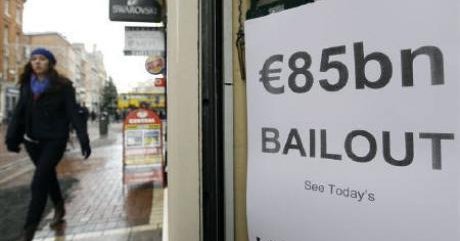During a JEF-Germany seminar this weekend, lots of solutions to exit the crisis were discussed in detail, even before the debate started this morning with Jean-Claude Juncker, President of the Eurogroup and Italy’s Finance Minister Giulio Tremonti presenting their proposal for a so-called “E-Bond” in the Financial Times. This proposal is based on the “blue bond” idea published by the Bruegel think tank this year. Let’s have a short look at it in order to understand why this could be an important step out of the crisis and a towards a more federal Europe.
Where do we stand now?
Imagine the following: You are walking around with a friend and want to buy something but currently have no money with you. So you ask your friend if he can lend you 100€. That means you are illiquid, you don’t have the money right now but you are going to pay back the 100€ to your friend. What if you ask for an amount of money that’s bigger than what you can actually pay back? That means you are insolvent, you will not be able to pay back. Countries are practicing something very similar. They run into debts which is quite a regular phenomenon and they do so by borrowing of the financial markets. They issue a so-called “bond” and you can go to your bank and buy or invest into a German or French bond. By doing so you give money to the state which will be returned in a certain amount of time (3 years for example) plus an additional interest or gain.
Certain countries, such as Greece, are no longer able to pay the money back, they are insolvent. Ireland is now in the same situation and fear is spreading that other countries might be affected too. Investors being afraid stop investing in bonds – why should they do so knowing they won’t be paid back? So the “price” (interest-rates) of certain Euro-members is going up. This fear thus makes the situation for these countries even more difficult because the more expensive it is to borrow money, the more likely an insolvency preventing them from paying back the old accumulated debts.
What can be done?
One could let Greece and comrades go bankrupt or kick them out of the Eurozone. That’s not a wise thing to do since there would be a run on Greek banks (like it happened in Brazil, Argentina and Russia), harming not only the Greek economy but also investors (mainly European banks) and cause a new post-Lehmann banking-crisis. Capital would be taken from Europe leaving its banks without capital and creating a much more severe scenario.
What was done to help Greece was to create a crisis-mechanism. 750 billion € were guaranteed for Greece in case it needs money, in other words: European countries (and not financial markets) lend money to Greece. But didn’t we say Greece is insolvent and not illiquid? Hopes were that Greece would get back into a solvent situation by starting to radically cut its debts. At the same time the high amount of money was supposed to “ring-fence” Greece – to strengthen the markets and prevent other Euro members of stepping into the same money-trap to stop “contagion”.
That didn’t work out, the crisis spread over to other countries and some argue that the guaranteed money (750 bio €) is insufficient to bail-out a country the size of Spain. In a worst case scenario several trillion € would be necessary. And still the problem won’t be solved: The crisis mechanism is actually supposed to be valid for three years only. What happens after that?
The risk would be pooled and if something happens to a country, a certain amount of money is guaranteed by all Euro members jointly.
Other solutions
Other solutions being discussed aren’t always mutually exclusive. An idea that gained momentum these weeks was the “blue bond” for Europe. The proposal by the Bruegel think tank was to pool all bonds of the European Member States into one “blue bond”. So if someone wanted to invest money he would no longer buy Belgian or Italian bonds but a “blue bond”. As the risk in Greece is high and low in Germany, the price (interest-rate) of this common bond would be somewhere in the middle. But the blue bond idea goes even further. It proposes that only a certain amount of public debts will be pooled that way (40% or 60% of public debts per GDP for example). If a country has more debts than that, it still has to issue national “red bonds”.
Like this the risk would be pooled and if something happens to a country, a certain amount of money is guaranteed by all Euro members jointly. If a country goes bankrupt, the money in the red bond has to enter insolvency – the private creditors have to loose (part of) their money. This is also an incentive for countries to keep their debts low because blue bonds are cheaper than the red ones as they reflect the risk of a country going bust.
This solution is cheaper for countries like Germany than bailing out Greece, Ireland and co, but the problem are the political costs. There is a debate going on in Germany about “lazy Southern Europeans” – which is not true, but the underlying reasons for the Euro-Crisis demand another article. As the idea of a blue bond is gaining momentum with scientists and high-ranking politicians, this is the perfect time to advocate that idea. It would be a way out of the crisis, being the cheapest solution for countries like Germany in favour of bailing out, and an important step towards European integration.
Would this be a transfer union? I would argue no. The risk is pooled but if the crisis is ended by such a bond Germany doesn’t have to pay expensive guarantees anymore. It would also be a step towards mutual fiscal confidence within the European Union – which is currently at zero. In addition to other elements such as a better supranational macroeconomic-coordination (long-term) and maybe also more supranational investments (mid-term) it could be a way out of the crisis and more importantly prevent new ones. It would not only strengthen the Eurozone but also be an important step in achieving more federalism.


Follow the comments: |
|
